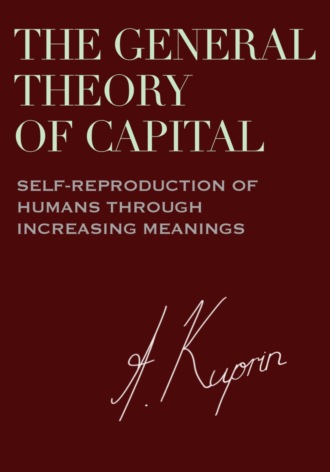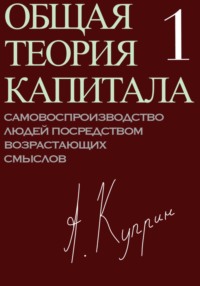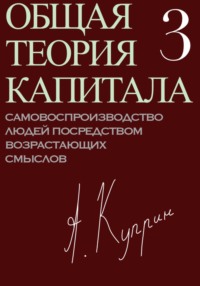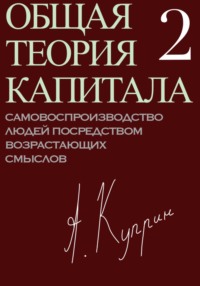
Полная версия
The General Theory of Capital: Self-Reproduction of Humans Through Increasing Meanings
Genes do not divide or mix, they are particles. At the same time they appear on the surface as continuous phenotypic traits: a person’s height or skin color can take on any value within a certain interval. Dawkins raised the question of whether memes are particulate (Dawkins 1976, p. 209; Mesoudi 2011, pp. 41-42). According to Alex Mesoudi, units of cultural heredity are not particulate, unlike genes:
“Memetics makes the neo-Darwinian assumption that culture can be divided into discrete units that are inherited in a particulate fashion, like genes. It also assumes that memes are transmitted with high fidelity, this being one of the defining characteristics of a replicator according to Dawkins. However, whereas genetic inheritance is particulate, cultural inheritance in many cases appears to be nonparticulate” (Mesoudi 2011, p. 42).
In reality, meanings have the properties of both a discrete and a continuous set. The discreteness of meaning is reflected in the fact that a single meaning can be isolated and defined. The continuity of meaning is reflected in the fact that meanings exist only in their movement: unlike a meme, meaning does not exist separately from human society, like a “cultural gene” that may or may not be transmitted between humans. Meanings are not “cultural genes” but human actions and their results, the totality of their material, social and abstract aspects.
Meaning is not an analogue of a gene, since it does not come from another meaning or even from a discrete set of meanings, but from their continuous set, which in the process of transmission and elaboration forms a culture. In essence, Culture represents a single Meaning that is both an inherited and an acquired property. While new genes can only arise from existing genes, new meanings—counterfacts—arise from the interaction of the subject and his culture with the natural and cultural environment: counterfacts arise from a set of meanings and non-meanings. Counterfacts come not only from variations in cultural traditions transmitted through learning, but also from an intellect solving problems in a changing environment. In other words, meaning as the substance and determinateness of culture depends on man as its subject and direction:
“Ideas and items of technology also have no stable analogue to the genome, or germline, because different elements within cycles of technological reproduction, including ideas, behaviors of artisans, and material elements of technologies themselves, can all temporarily acquire the status of replicators depending on the attention that human agents happen to be paying to them. Accidental variations in one’s mental plan for constructing a pot, or in one’s actions in producing the pot, or in the made pot itself, can all conceivably be reproduced when another artisan comes to make a resembling item” (Lewens 2018).
Biologists studying a minimum genome that would allow organisms to exist and reproduce assume that such a genome consists of 256 active genes (Hutchison et al. 2016). In nature, the bacterium mycoplasma genitalium has the smallest known genome among self-reproducing organisms—525 genes. The human genome contains 20,000 to 25,000 active genes. To date, there is no research on the minimum set of meanings that would trigger cultural evolution. Human culture began with a scanty set of primitive meanings, perhaps with a few simple tools, causal mini-models and an elementary tongue. However, by the time when Ötzi lived 5,300 years ago—a man from the Copper Age whose mummy and personal effects were discovered in the Alps in 1991— the meanings had multiplied to the point that a multi-story museum building is required to store and research them. And modern human culture is an immense accumulation of meanings that would require an encyclopedia of thousands of volumes to describe.
Simple consumption and unfolding of needs
The accumulation of meanings begins when proto-humans transform their habitat into a means and adapt it to their needs. The accumulation of meanings, in turn, leads to the unfolding of needs (Korotaev 2003, pp. 32-33). The unfolding of needs implies, first, that animal needs become more cultural and, second, that new more cultural needs emerge. Above, we called this transition the “needs trap” with which human history began. “…The satisfaction of the first need, the action of satisfying and the instrument of satisfaction which has been acquired, leads to new needs; and this creation of new needs is the first historical act” (Marx and Engels 1975-2004, vol. 5, p. 42). In this transition, not only animals but also their needs are transformed into a mixture of life and meaning.
The unfolding of needs initially takes place within the framework of cultural selection. As humans advanced from cultural selection to choice, the satisfaction of needs unfolded into a meaningful process of consumption, that is, an increasingly targeted appropriation and elaboration of the material of nature. Traditional/simple consumption is based on the gradual expansion of the domus, the cultural niche of humans within the natural environment. Primitive people are still firmly embedded in nature and follow its rhythms:
“Close observers of hunter-gatherer life have been struck by how it is punctuated by bursts of intense activity over short periods of time. The activity itself is enormously varied—hunting and collecting, fishing, picking, making traps and weirs—and designed in one way or another to take best advantage of the natural tempo of food availability. ‘Tempo,’ I think, is the key word here. The lives of hunter-gatherers are orchestrated by a host of natural rhythms of which they must be keen observers” (Scott 2017, p. 88).
As the domus expanded, a cultural rhythm of its own evolved. The nomadic life of hunters and gatherers gave way to the more settled life of farmers. Technological changes, which were very slow, were accompanied by equally slow changes in organization and psychology. Tribes became chiefdoms and chiefdoms became states. Fetishism and animism were augmented, though not superseded, by totemism and polytheism.
The more meaningful consumption is, the more the needs are cognitively represented as values. Emotional behavior is gradually supplemented by traditional behavior as a prelude to rational action. “The line between meaningful action and merely reactive behavior to which no subjective meaning is attached, cannot be sharply drawn empirically. A very considerable part of all sociologically relevant behavior, especially purely traditional behavior, is marginal between the two” (Weber 1978, pp. 4-5).
William Durham has noted that cultural variants (we would say, meanings and counterfacts as alternative meanings) are socially transmitted, so they are not necessarily reproduced at the individual level, but can be retained or rejected by social choice (Durham 1991, p. 192). In fact, what needs to be explained is not how individual choice creates social choice, but where individual decisions come from and how they are possible. Historically, traditional choice began not with decisions made by individuals, but with social choice based on order and inherited practices.
Needs are not satisfied on the basis of a single norm or a single emotion. The unfolding of needs occurs within a broad framework of many norms, within the socio-cultural order. Values are the result of a choice in which different norms and emotions, morals and motives compete with each other. A person finds himself between norms and emotions. In the evolutionary process of selection and choice, norms and emotions as well as needs unfold.
For the vast majority of the population, simple consumption is limited to the satisfaction of needs essential to survival. These minimum needs, the satisfaction of which is necessary for the continuation of existence, play a central role in simple consumption. We call this first type of need subsistence needs. They ultimately develop into utilitarian motives.
The second type is communication needs. Simple consumption takes place in relatively small and isolated communities of several dozen or hundreds of people. In small communities, the satisfaction of the need for sociality, respect and social contacts serves primarily to maintain cohesion, distinguish between “us” and “them,” and establish social status.
The third type is the need for self-expression. In a traditional society, this is the least developed type: it arises later than the first two types and plays a minor role. Since primitive meanings are the result of cultural selection, not choice, and their main content is stability and not change, the need for self-expression remains inessential and sometimes harmful to the self-reproduction of traditional societies. Dreamers and inventors are ignored or even persecuted.
For anarcho-primitivists like John Zerzan, the reason for the slow progress of primitive societies makes no mystery. The answer for him is that the primitive dreamers could not think of anything better than their simple life.
“During the vast time-span of the Paleolithic, there were remarkably few changes in technology. Innovation, ‘over 2½ million years measured in stone tool development was practically nil,’ according to Gerhard Kraus. Seen in the light of what we now know of prehistoric intelligence, such ‘stagnation’ is especially vexing to many social scientists. ‘It is difficult to comprehend such slow development,’ in the judgment of Wymer. It strikes me as very plausible that intelligence, informed by the success and satisfaction of a gatherer-hunter existence, is the very reason for the pronounced absence of ‘progress.’ Division of labor, domestication, symbolic culture—these were evidently refused until very recently” (Zerzan 2012, p. 7).
Rather, the reason for the lack of “progress” was not intelligence, but its subordinate position: the intellect was suppressed by tradition. Practice, not the intellect, was the main source of the most effective causal models. Increasing the degree of adaptation in a simple society meant bringing the causal models closer to reality and thus strengthening man in his relationship with nature. The unfolding of needs, motives and activities requires an expansion of choices, but under cultural selection and traditional choice this expansion advanced extremely slowly.
Chapter 2. Simple production and necessary activity
1. Development of production from consumption
Agricultural evolution and increasing meanings
If Homo sapiens were simply a large mammal, like a wolf or a bear, its total population would not exceed several hundred thousand (Kapitsa 2009, p. 15). For example, the number of gray wolves in the world is about 300,000 individuals, the same number applies to chimpanzees. The transformation of man into a cultural being allowed him to exceed the limits set by nature. 100,000 years ago, 1 million people lived in the world. 10,000 years ago, when agricultural evolution began, 5 to 10 million people lived, and many of them depended on (semi-)domesticated animals and plants for reproduction. The further agricultural evolution advanced, the more people there were. At the turn of our era, there were about 250 million people living on Earth, most of whom were farmers and herders, not hunters and gatherers. At the beginning of the Industrial Revolution, the world’s population was about 1 billion people (Malanima 2009, pp. 1 ff.).
The accumulation of meanings first led to the separation of culture from nature. Subsequently, the same process led to the separation of production from consumption. Agricultural production arose approximately 10,000 to 12,000 years ago through the domestication of plants and animals. Neolithic evolution may have been a rapid event by Paleolithic standards, but by the standards of modern socio-cultural change it was a very slow, gradual development of a productive economy. Recent research suggests that domestication itself was a long process:
“First, it makes the identification of a single domestication event both arbitrary and pointless. Second, it reinforces the case for a very, very long period of what some have called ‘low-level food production’ of plants not entirely wild and yet not fully domesticated either. The best analyses of plant domestication abolish the notion of a singular domestication event and instead argue, on the basis of strong genetic and archaeological evidence, for processes of cultivation lasting up to three millennia in many areas and leading to multiple, scattered domestications of most major crops (wheat, barley, rice, chick peas, lentils)” (Scott 2017, p. 12).
There was no clear boundary, but rather a transition between foraging and agriculture, between food appropriation and food production. James Scott calls this transition “illegible” production (Scott 2017, p. 33). “Illegible” production was characterized by two moments. First, meanings grew in objects, means of activity and the subject itself: plants, animals, and humans transformed from products of pure nature into products of human action. Second, the transition from hunting and gathering to herding and farming changed the rhythm and patterns of activity.
The advent of a relatively warmer and more stable climate at the beginning of the Holocene meant that in some areas, such as the Fertile Crescent region humans could reproduce without being nomadic. It became possible to obtain food by hunting, fishing, and gathering wild plants while remaining sedentary. The possibility of large seasonal food surpluses led to increased population density in areas with fish spawning grounds or natural grain fields. Seasonal food surpluses and the need to store food required long-term planning:
“A food supply dependent on a few seasonal energy flows required extensive, and often elaborate, storage. Storage practices included caching in permafrost; drying and smoking of seafood, berries, and meats; storing of seeds and roots; preservation in oil; and the making of sausages, nut-meal cakes, and flours. Large-scale, long-term food storage changed foragers’ attitudes toward time, work, and nature and helped stabilize populations at higher densities. The need to plan and budget time was perhaps the most important evolutionary benefit. This new mode of existence precluded frequent mobility and introduced a different way of subsistence based on surplus accumulation” (Smil 2017, p. 39).
The transition to sedentism did not depend on the unique characteristics of a particular area. Within a few thousand years, populations became sedentary not only in many regions of the Old World (Middle East, India, China), but also in the New World. The fact that this transition occurred almost simultaneously (at least, by prehistoric standards) in different parts of the world suggests that it was the result of some crucial changes in the evolution of culture-society that coincided with the climate changes at the beginning of the Holocene.
The shift to a food-producing economy was gradual and based on the use of a natural effect that reduced the labor intensity required for growing grain. Just as fire enables the clearing of forests and slash-and-burn creates a nutrient layer for plants and animals useful to humans, periodic ebb and flow in the floodplains of large rivers creates a layer of nutrients for sowing grain. Floods were the natural effect that intelligent and work-shy hunter-gatherers used for agriculture in alluvial plains (Scott 2017, p. 67):
“The general problem with farming—especially plough agriculture—is that it involves so much intensive labor. One form of agriculture, however, eliminates most of this labor: ‘flood-retreat’ (also known as decrue or recession) agriculture. In flood-retreat agriculture, seeds are generally broadcast on the fertile silt deposited by an annual riverine flood. The fertile silt in question is, of course, a ‘transfer by erosion’ of upstream nutrients. This form of cultivation was almost certainly the earliest form of agriculture in the Tigris-Euphrates floodplain, not to mention the Nile Valley. It is still widely practiced today and has been shown to be the most labor-saving form of agriculture regardless of the crop being planted” (Scott 2017, p. 66).
Agriculture was initially just an additional source of food for hunters and gatherers, who settled in the lower reaches of the rivers along the sea coast near rich food sources. For primitive communities, however, abundant food was not the rule, but rather a rare exception:
“For some groups the total foraging effort was relatively low, only a few hours a day. This finding led to foragers being portrayed as ‘the original affluent society,’ living in a kind of material plenty filled with leisure and sleep (Sahlins 1972). Most notably, Dobe !Kung people of the Kalahari Desert in Botswana, living on wild plants and meat, were thought to provide an excellent window on the lives of prehistoric foragers, who allegedly led contented, healthy, and vigorous lives. This conclusion, based on very limited and dubious evidence, must be—and has been—challenged. … A reanalysis of energy expenditure and demographic data collected in the 1960s found that the nutritional status and health of Dobe !Kung ‘were, at best, precarious and, at worst, indicative of a society in danger of extinction’ (Bogin 2011)” (Smil 2017, p. 37).
The subsequent spread of agriculture (at least in Europe) occurred due to the migration of members of agrarian communities, rather than due to hunter-gatherers willingly adopting the agricultural practices of their neighbors (Smil 2017, pp. 43-44). This may suggest that agriculture had no clear advantages over hunting and gathering. The shift to farming represented, in a sense, the collapse of primitive society. James Scott notes that the transition from hunting and gathering to agriculture entails a more monotonous rhythm and simpler activities:
“I am tempted to see the late Neolithic revolution, for all its contributions to large-scale societies, as something of a deskilling. Adam Smith’s iconic example of the productivity gains achievable through the division of labor was the pin factory, where each minute step of pin making was broken down into a task carried out by a different worker. Alexis de Tocqueville read The Wealth of Nations sympathetically but asked, ‘What can be expected of a man who has spent twenty years of his life putting heads on pins.’” (Scott 2017, p. 92). “It is no exaggeration to say that hunting and foraging are, in terms of complexity, as different from cereal-grain farming as cereal-grain farming is, in turn, removed from repetitive work on a modern assembly line. Each step represents a substantial narrowing of focus and a simplification of tasks” (ibid., p. 90).
Primitive societies were not societies of affluence. Hunter-gatherers did not lead lives of idleness, but neither were they forced to work hard or monotonously. With the exception of flood farming, agriculture constitutes a much more laborious occupation than hunting and gathering:
“As Ester Boserup and others have observed, there is no reason why a forager in most environments would shift to agriculture unless forced to by population pressure or some form of coercion” (Scott 2017, p. 20). “Why would foragers in their right mind choose the huge increase in drudgery entailed by fixed-field agriculture and animal husbandry unless they had, as it were, a pistol at their collective temple? We know that even contemporary hunter-gatherers, reduced to living in resource-poor environments, still spend only half their time in anything we might call subsistence labor” (ibid., p. 93).
If the transition from hunting and gathering to herding and farming involved an obvious simplification of life and more arduous work, why did it happen at all? The reason may have been the creation of surpluses or reserves that reduced environmental uncertainty, allowed time and resources to be allocated more efficiently, and thus freed up for activities other than food production. Religion, war, crafts and trade were the causes of farming and herding, at least insofar as farming and herding were their causes. Since the simplification of the individual live was accompanied by the complication of community live, individuals had to adapt to the rhythms of culture rather than nature. The transition to agricultural production occurred at the level of culture-society rather than at the level of individuals, many of whom suffered from this transition. The main driving force behind the transition was competition between communities, their leaders, and their meanings.
The prerequisite and at the same time consequence of the transition to a sedentary lifestyle and agriculture was the increase in population density. While the average population density in hunter-gatherer communities was 25 people per 100 square kilometers (Smil 2017, p. 28), slash-and-burn agriculture made it possible to feed 100 times more people: from 2,000 for corn farmers in North America to 6,000 for rice and tuber farmers in Southeast Asia (ibid., p. 45). Finally, in such developed agricultural production as the rice fields of the Ming and Qing dynasties, the corn plantations of the Aztecs, or the potato fields of the Incas, the population density reached tens of thousands of people per 100 square kilometers of cultivated area (ibid., pp. 95, 98-99).
Scott shows that the domestication of humans, plants and animals and their crowding into the domus, worsened their health and increased the mortality rate. At the same time, the transition to sedentary life increased the birth rate so much that it more than compensated for the increased mortality: the value of children as labor force is higher for a peasant than for a hunter-gatherer. So the rise of agrarian societies led to the displacement of hunter-gatherers (Scott 2017, pp. 82-83, 113-114).
We saw above that the emergence of culture became the first “needs trap”: when hominids resorted to meanings for self-reproduction, they could no longer remain animals, but had to evolve into humans. The transition to agriculture proved to be the second “needs trap.” Once an agrarian culture-society had emerged, it could not return to the hunter-gatherer state since it would not have been able to feed itself.
More people meant more meaning and faster evolution. We can identify four variables that influence the level of complexity and speed of evolution of a culture-society: (1) diversity; (2) connectedness; (3) interdependence; (4) adaptation or learning (Page 2009, pp. 10-12). The increase in population size and density in early agrarian societies affected all four variables.
“Human population grew in a sort of chain reaction in which greater density of occupation of territory tended to produce new opportunities for specialization and thus led to an increase of individual productivity and in turn to a further increase of numbers. There also developed among such large numbers of people not only a variety of innate attributes but also an enormous variety of streams of cultural traditions among which their great intelligence enabled them to select—particularly during their prolonged adolescence” (Hayek 1988-2022, vol. 1, p. 126).
The increase in population, its density and specialization associated with the development of agricultural production led to greater diversity, connectedness and interdependence: people became more different, the number and intensity of their contacts expanded.
“Prehistoric changes brought about by better tools, the mastery of fire, and better hunting strategies were very slow, unfolding over tens of thousands of years. The subsequent adoption and intensification of permanent farming lasted for millennia. Its most important consequence was a large increase in population densities, leading to social stratification, occupational specialization, and incipient urbanization” (Smil 2017, p. 407).
Nevertheless, increasing population density, coupled with the concentration of livestock, domesticated plants and parasites, often led to massive epidemics and the collapse of entire civilizations. In an agrarian society, the vast majority of the population can only satisfy their minimum needs through subsistence farming. The primitive economy relied mainly on agriculture, on the achievements of which the slow evolution of society largely depended. We would not be mistaken if we said that about three-quarters to four-fifths of the traditional labor force was employed in agriculture (cf. Livi Bacci 2000, p. 12).






